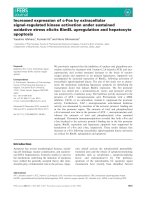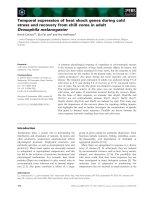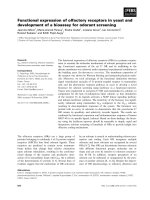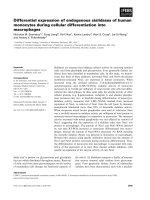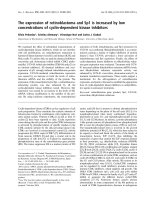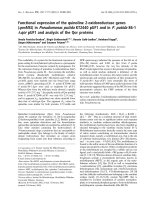báo cáo khoa học: "Reduced expression of SMAD4 in gliomas correlates with progression and survival of patients" ppt
Bạn đang xem bản rút gọn của tài liệu. Xem và tải ngay bản đầy đủ của tài liệu tại đây (751.88 KB, 7 trang )
RESEARCH Open Access
Reduced expression of SMAD4 in gliomas
correlates with progression and survival of
patients
Shi-ming He, Zhen-wei Zhao, Yuan Wang, Ji-pei Zhao, Liang Wang, Fang Hou and Guo-dong Gao
*
Abstract
Background: To examine the expression of SMAD4 at gene and protein levels in glioma samples with different
WHO grades and its association with survival.
Methods: Two hundreds fifty-two glioma specimens and 42 normal control tissues were collected.
Immunochemistry assay, quantitative real-time PCR and Western blot analysis were carried out to investigate the
expression of SMAD4. Kaplan-Meier method and Cox’s pro portional hazards model were used in survival analysis.
Results: Immunohistochemistry showed that SMAD4 expression was decreased in glioma. SMAD4 mRNA and
protein levels were both lower in glioma compared to control on real-time PCR and Western blot analysis (both P
< 0.001). In addition, its expression levels decrease from grade I to grade IV glioma according to the results of real-
time PCR, immunohistochemistry analysis and Western blot. Moreover, the survival rate of SMAD4-positive patients
was higher than that of SMAD4-negative patients. We further confirmed that the loss of SMAD4 was a significant
and independent prognostic indicator in glioma by multivariate analysis.
Conclusions: Our data provides convincing evidence for the first time that the reduced expre ssion of SMAD4 at
gene and protein levels is correlated with poor outcome in patients with glioma. SMAD4 may play an inhibitive
role during the devel opment of glioma and may be a potential prognosis predictor of glioma.
Keywords: glioma, SMAD4, Immunochemistry assay, Quantitative real-time PCR, Western blot analysis, prognosis
1. Introduction
Human gliomas are the most common primary intracra-
nial tumors in adults. A grading scheme proposed by
the WHO distinguishes four different grades of gliomas,
of which glioblastoma multiforme (GBM) WHO grade
IV is the most malignant variant with a median survival
time of 1 year [1]. Many aggressive treatment
appr oaches, such as postoperative radiation therapy and
chemotherapy, have been used clinically. However, these
approaches do not benefit all patients equally. Adverse
effects of these approaches even dramatically deteriorate
the quality-of-life of some patients. Therefore, individua-
lized therapy should be considered as a valuable
approach for patients with high-g rade gliomas. Molecu-
lar profiling of gliomas may define the critical genetic
alterations that underlie glioma pathogenesis and their
marked resistance to therapy [2]. So elucidation of these
critical molecular e vents will improve therapy and indi-
vidualize therapeutic interventions for patients with
gliomas.
Mothers against decapentaplegic homolo gue 4
(SMAD4), expressed ubiquitously in different human
organ systems, was initially isolated as a tumor suppres-
sor gene on chro mosome 18q21.1 in pancreatic ductal
adenocar cinomas [3]. The SMAD4 protein is the down-
stream mediator of transforming growth factor beta
(TGF-b), which is an important multifunctional cytokine
that regulates cell proliferation, differentiation and extra-
cellular matrix production [4]. Conflicting data exist
about the influence of SMAD4 on the developmen t and
progression of various human tumors. Papageorgis et al.
reported that SMAD4 inactivation promotes malignancy
and drug resistance of colon cancer [5]. The study of
* Correspondence:
Department of Neurosurgery, Institute for functional neurosurgery P.L.A,
TangDu Hospital, Fourth Military Medical University, Xi’an, 710038, PR China
He et al. Journal of Experimental & Clinical Cancer Research 2011, 30:70
/>© 2011 He et al; licensee BioMed Central Ltd. This is an Open Access article distributed under the terms of the Creative Commons
Attribution License ( which permits unrestricted use, distribution, and reproduction in
any medium, provided the original work is properly cited.
Sakellariou et al. found that SMAD4 may behave as a
tumor promoter in low grade gastric cancer and the sur-
vival rates were significantly higher for patients with
reduced SMAD4 expression, in cases of we ll- or moder-
ately differentiated tumors [6]. In pancreatic cancer,
inactivation of the SMAD4 gene through mutation
occurs frequently in association with malignant progres-
sion [7]. In non-small-cell lung carcinoma, immunohis-
tochemistry revealed that SMAD4 was expressed at high
level in normal broncho-tracheal epithelium, but at low
level in tumor tissues, and closely correlated with tumor
lymph node metastasis [8]. Lv et a l. also demonstrated
that the hypo-expression level of SMAD4 was associated
with the pathological stage, and lymph node metastasis
of the patients with esophageal squamous cell carci-
noma, however, it might not be th e independent prog-
nostic factor [9]. On the other hand, Sheehan et al.
indicated that SMAD4 protein expression persists in
prostatic adenocarcinomas compared with benign
glands, with both nuclear and cytoplasmic overexpres-
sion correlating with prognostic variables indicative of
aggressive tumor behavior [10]. Hiwatashi et al. also
concluded that strong SMAD4 expression in hepatocel-
lular carcinoma is likely to suggest poor prognosis of
patients [11]. However, little is known about the expres-
sion level of SMAD4 or its prognostic significance in
human gliomas.
In order to gain further insight into the status of
SMAD4 in the progression of glioma, we used immuno-
chemistry assay, quantitative real-time PCR and Western
blot analysis to investigate the expression pattern of
SMAD4 in glioma specimens and normal control brain
tissues. Next, we analyzed the relationship between
SMAD4 expression and the glioma stage as well as the
survival of patients.
2. Materials and methods
2.1 Patients and Tissue Samples
This study was approved by the Research Ethics Com-
mittee of the Institute for functional neurosurgery P.L.A,
TangDu Hospital, Fourth Military Medical University,
Xi’ an,P.R.China.Writteninformedconsentwas
obtained from all of the patients. All specimens were
handled and made anonymous according to the ethical
and legal standards.
Fresh glioma specimens were obtained from 252
patients who underwent surgery between May 2002
and April 2005. None of the patients had received
radiotherapy or chemotherapy prior to surgery. About
42 normal brain tissue samples were taken from
patients who underwent surgery for reasons other than
malignancy such as cerebral trauma. This served as the
control. Tumors were his topathologically classified
according to the WHO classification. Patient data
included age, sex, date and type of initial operation,
and details of the follow-up. Clinical information was
obtained by reviewing the medical records on radio-
graphic images, by telephone or written correspon-
dence, and by review of death certificate. A patient
was considered to have recurrent disease if this was
revealed either by magnetic resonance imaging or the
occurrence of new neurologic symptoms. Parts of the
specimens were fixed in 10% formaldehyde and
imbedded in paraffin for histological sections. Other
parts were put into liquid N2 for 10 min, then into a
-70°C ultra-freezer for mRN A and protein isolation. In
the follow-up period, overall survival was measured
from diagnosis to death or last follow-up.
2.2 Immunohistochemistry assay
Immunohistochemical assay was performed using the
conv entional immunoperoxidase technique according to
the protocol of the Department of Neurosurgery, I nsti-
tute for functional neurosurgery P.L.A, TangDu Hospi-
tal, Fourth Military Medical University, Xi’ an, P.R.
China. Briefly, following peroxidase blocking with 0.3%
H2O2/methanol for 30 min, specimens were blocked
with phosphate-buffered saline (PBS) containing 5% nor-
mal horse serum (Vector Laboratories Inc., Burlingame,
CA, USA). All incubations with anti-SMAD4 antibody
(clone B-8, Santa Cruz Biotechnology Inc, Heidelberg,
Germany) at 1:50 dilution were carried out overnight at
4°C. Then the specimens were briefly washed in PBS
and incubated at room temperature with the anti-mouse
antibody and avidin-biotin peroxidase (Vector Labora-
tories Inc., Burlingame, CA, USA). The specimens were
then washed in PBS and color-developed by diamino-
benzidine solution (Dako Corporation, Carpinteria, CA,
USA). After washing w ith water, specimens were coun-
terstained with Meyer’ s hematoxylin (Sigma Chemical
Co., St Louis, MO, USA). Normal brain tissues were
used as control tissues and non-immune IgG was also
used as negative control antibody for immunohisto-
chemical staining.
Stained sections were observed under a microscope.
Immunostaining was scored by two independent experi-
enced pathologists, who were blinded to the clinico-
pathologic parameters and clinical outcomes of the
patients. An i mmunoreactivity score system was applied
as described previously [12]. The extensional standard
was: (1) the number of positively stained cells <5%
scored 0; 6-25% scored 1; 26-50% scored 2; 51-75%
scored 3; >75% scored 4; (2) intensity of stain: colorless
scored 0; pallide-flavens scored 1; yellow scored 2;
brown scored 3. Multiply (1) and (2). The staining score
was stratified as - (0 score, absent), + (1-4 score, weak),
++ (5-8 score, moderate) and +++ (9-12 score, strong)
according to the proportion and intensity of positively
He et al. Journal of Experimental & Clinical Cancer Research 2011, 30:70
/>Page 2 of 7
stained cancer cells. Specimens were rescored if differ-
ence of scores from two pathologists was >3.
2.3 Quantitative real-time PCR
Total RNA purified from all 252 glioma tissues and 42
control brain tissues was prepared and reverse tran-
scribed. Real-time monitoring of polymerase chain reac-
tions (PCRs) was performed using the ABI 7900HT
(Idaho Technology, Idaho Falls, ID, USA) and the SYBR
green I dye (Biogene), which binds preferentially to dou-
ble-stranded DNA. Fluorescence signals, which are pro-
portional to the concentration of the PCR p roduct, are
measured at the end of each cycle and immediately dis-
played on a computer screen, permitting realtime moni-
toring of the PCR. The reaction i s characterized by the
point during cycling when amplification of PCR pro-
ducts is first detected, rather than the amount of PCR
product accumulated after a fixed number of cycles.
The higher the starting quantity of the template, the
earlier a significant increase in fluorescence is observed.
The threshold cycle is defined as the fractional cycle
number at which fluorescence passes a fixed threshold
above the baseline. The primers 5’-TATTAAGCA
TGC TAT ACA ATC TG -3’ and 5’ - CTT CCA C CC
AGA TTT CAA TTC -3’ were used to amplify 332-bp
transcripts of SMAD4 and the primers 5’ - GGT GGC
TTT TAG GAT GGC A AG -3’ and 5’- ACT GGA ACG
GTG AAG GTG ACA G -3’ were used to amplify 161-
bp transcripts of b-actin. All primers were synthesized
by Sangon Co. (Shanghai, China). The PCR profile con-
sisted of an initial melting step of 1 min at 94°C, fol-
lowed by 38 cycles of 15 s at 94°C, 15 s at 56°C and 45
s at 72°C, and a final elongation step of 10 min at 72°C.
Fluorescence data were converte d into cycle threshold
measurements using the SDS system software and
exported to Microsoft Excel. SMAD4 mRNA levels were
compared to b-actin. Thermal dissociation plo ts were
examined for biphasic melting curves, indicative of
whether primer-dimers or other nonspecific products
could be contributing to the amplification signal.
2.4. Western blot analysis
Glioma and normal brain tissues were homogenized in
lysis buffer [PBS, 1% nonidet P-40 (NP-40), 0.5% sodium
deoxycholate, 0.1% sodium dodecyl sulfate (SDS), 100
ug/ml aprotinin, 100 μg/ml phenylmethylsulfonyl fluor-
ide (PMSF), Sodium orthovanadate] at 4°C throughout
all procedures, and sonic ated for 70 s, the n add 300 μg
PMSF per gram of tissue and incubate on ice for 30
min, followed by centrifugation at 15,000 rpm for 20
min at 4°C. The protein content was determined accord-
ing to Bradford’s method (Bradford 1976), with bovine
serum albumin used as a standard. Protein samples (30
μg) were boiled with 2 × sample buffer containing 5%
b-mercaptoethanol for 5 min, separated by size on 15%
polyacrylamide gel under SDS denaturing conditions,
and transferred to a nitrocellucose membrane at 90 V
for 2 h. The nitrocellulose membranes were stained
with ponceau S to assess the efficiency of transfer. Non-
specifi c binding was blocked by incubation in block
buffer (5% non-fat dry milk, 0.05% Tween-20, 1 × tris-
Cl-buffered saline) overnight at 4°C, The membranes
were hybridized with mouse monoclonal antibody
recognizing SMAD4 (sc-7 966, Santa Cruz Biotechnol-
ogy, Inc., Santa Cruz, CA), then incubated with a horse-
radish peroxidase-labeled goat anti-mouse IgG (1: 500).
The bound secondary antibody was detected by
enhanced chemiluminescence (Amersham Life Science,
Little Chalfont, UK). Housekeeping protein b-actin was
used as a loading control. Positive immunoreactive
bands were quantified densitometri cally (Leica Q500IW
image analysis system) and expressed as ratio of
SMAD4 to b-actin in optical density units.
2.5 Statistical analysis
All computations were carried out using the software of
SPSS version13.0 for Windows (SPSS Inc, IL, USA). The
rank sum test was used to analyze the ranked data. The
measurement data were analyzed by one-way ANOVA.
Randomized block design ANOVA was used to analyze
the statistical difference among different tissue types. In
the analysis of glioma morbidity for all patients, we used
the Kaplan-Meier estimator and univariate Cox regres-
sion analysis to assess the marginal effect of each factor.
The differences between groups were tested by log-ran k
analyses. The joint effect of different factors was
assessed using multivariate Cox regression. A Spear-
man’s analysis was carried out to analyze the correlation
between SMAD4 mRNA and protein expression levels.
Differences were considered statistically significant when
p was less than 0.05.
3. Results
3.1 SMAD4 protein levels in glioma tissues by
immunohistochemistry assay and survival analysis
SMAD4 expression was studied in a total of 252 glioma
specimens of which 113 were low grade glioma (grade I
and II) and 139 were high grade (grade III and IV).
About 42 specimens taken from normal brain tissue
served as control group. Based on immunohistochemis-
try analysis, positive staining for SMAD4 was mainly
observed in the cytoplasm and to a lesser degree in the
nuclei of cancer cells. The representative photographs
were shown in Figure 1. Among the glioma specimens,
138 (54.8%) glioma specimens were positively stained,
and 114 (45.2%) glioma specimens were negatively
stained. Among the control specimens, 34 (81.0%) were
positively stained, and 8 (19.0%) were negatively stained.
He et al. Journal of Experimental & Clinical Cancer Research 2011, 30:70
/>Page 3 of 7
We also found a significant decrease of SMAD4 expres-
sion in glioma compared with normal brain tissue s (P <
0.001).
In addition, SMAD4 expression was not significantly
affected by the gende r and age (both P > 0.05) of the
patients. In contrast, the SMAD4 expression was the
closely correlated with WHO grade (Table 1; P = 0.008),
as well as Karnofsky performance Status (KPS) (Table 1;
P < 0.001).
Moreover, we reviewed clinical information of these
SMAD4-positive or -negative glioma patients. During
the follow-u p period, 197 of the 252 glioma pati ents
(78.2%) had died (108 from the SMAD4-negative group
and 142 from the SMAD4-positive group). As deter-
mined by the log-rank test, the su rvival rate of patients
without SMAD4 staining was lower than those showing
SMAD4 positive staining (P < 0.001; Figure 2A). The
median survival time of patients with strong po sitive (+
++) expression of SMAD4 could not be estimated by
statistical analysis because all patients survived better
than the overall median level, and those patients with
moderate positive (++), weak positive (+) and negative
expression of SMA D4 were 22.8 ± 1.3 months, 13.2 ±
1.6 months and 8.0 ± 0.5 months (log-rank test: P <
0.001).
Furthermore, Figure 2B shows the post-operative sur-
vival curve of patients with glioma and SMAD4 expres-
sion after adjusting for age, gender, WHO grade and
KPS. By multivariate analysis, the loss of SMAD4
expression was a significant and independent prognostic
indicator for patients with glioma besides age, WHO
grade and KPS. The Cox proportional hazards model
showed that lower SMAD4 expression was associated
with poor overall survival.
3.2 Quantitative analysis of SMAD4 protein expression
based on WHO grade in gliomas
As the results of Western blot analysis, we found that
SMAD4 protein expression tended to increase from the
glioma to the normal tissue (Figure 3A, C). We also
investigated whether the expression of SMAD4 corre-
lated with the WHO grade. SMAD4 expression was
highest in grade I and lowest in grade IV (Figure 3B, C).
This result agreed with the findings of the immunohis-
tochemistry analysis and indicated a close correlation of
SMAD4 protein expression with WHO grade.
3.3 Quantitative analysis of SMAD4 gene expression in
glioma
We determined the mRNA expression of SMAD4 nor-
malized to b-actin by real-tim e PCR. As shown in Table
2, there was a conspicuous decrease in the expression of
SMAD4 mRNA from the control brain tissues to glioma
Figure 1 Immunohistochemical staining of SMAD4 protein in tumor cells of GBM (A) and astroc ytoma (B) (Original magnification
×400). Staining for this antigen is described in Materials and Methods. Positive staining of SMAD4 is seen in the cytoplasm and/or nuclei of
tumors cells and is more abundant in the low- (B) than the high-grade (A) tumors. Intensively positive expression of SMAD4 (C) was observed in
normal brain tissues.
Table 1 SMAD4 expression in human glioma tissues with
different clinical-pathological features
Clinicopathological
features
No. of
cases
SMAD4 (n) P
- + ++ +++
WHO grade 114 60 51 27
I 53 12 16 13 12 0.008
II 60 17 21 15 7
III 62 34 12 11 5
IV 77 51 11 12 3
Age
<55 152 65 39 31 17 NS
≥55 100 49 21 20 10
Gender
Male 138 57 36 30 15 NS
Female 114 57 24 21 12
KPS
<80 135 81 25 21 8 <0.001
≥80 117 33 35 30 19
He et al. Journal of Experimental & Clinical Cancer Research 2011, 30:70
/>Page 4 of 7
tissues (P < 0.001). We further an alyzed the expression
of SMAD4 mRNA based on KPS and WHO grade.
Interestingly, SMAD4 mRNA expression decreased in
patients whose KPS lower than 80 ( P < 0.001) and also
decreased with advancement of WHO grade I to grade
IV (P < 0.01). There was a significant positive correla-
tion between the expression of SMAD4 mRNA and pro-
tein expression levels from the same glioma tissues (rs =
0.886, P < 0.001).
4. Discussion
In the current study, we investigated the expression of
SMAD4 in 252 cases of human glioma and compared
the expression with tumor grade and survival rates of
patients. Our data demonstrated that SMAD4 protein
was decreased in glioma compared to normal brain tis-
sue. SMAD4 mRNA expression was also reduced in
glioma compared with control normal brain tissue. We
found a decreased trend of both SMAD4 protein level
and mRNA level from WHO grade I to WHO grade IV
glioma. These results suggest that the transcriptional
repression of human SMAD4 might participate in the
carcinogenesis and progression of glioma. SMAD4 may
have an importan t role d uring the genesis or progres-
sion of glioma.
SMAD proteins are the key intracellular mediators of
transcriptional responses t o TGF-b signaling which is
altered in various tumors [13]. They consistently t rans-
mit the TGF-b signal from the cell membrane to the
nucleus. The mammalian SMAD family consists of eight
members, which can be divided into three groups
according to their function: receptor-activated SMADs,
commonmediated SMADs, and inhibitory SMADs [14].
SMAD4 is o ne of the commonmediated SMADs and, in
general, SMAD4 is a central component of the TGF-b/
SMAD pathway and is expressed in different human
organ systems. TGF-b binds to homodimers of the
TGF-b type II receptor (TbRII) which recruits and acti-
vates homodimers of TGF-b type I receptor (TbRI) ser-
ine/threonine kinase. Activated TbRI phosphorylates
SMAD2 or SMAD3 which heterodimerize with SMAD4.
These heterocomplexes translocate into the nucleus
wheretheybindDNAandregulateTGF-b dependent
gene expression [15]. Deletion or degradation of
SMAD4 in tumors could specifically inhibit the tumor
suppressor effect of TGF-b. SMAD4 alteration has been
associated with specific loss of TGF-b induced growth
resulting in increased angiogenesis and loss of epithelial
integrity [16]. Recent studies have shown that SMAD4
inactivation is associated with the advanced disease state
of various human tumors, including pancreatic carci-
noma, esophageal carcinoma, colorectal carcinoma,
renal cell carcinoma, as well as breast carcinoma
[17-20]. Our results confirm that SMAD4 is
Figure 2 Postoperative survival curves for patterns of patients with glioma and SMAD4 expression. (A) Kaplan-Meier postoperative
survival curve for patterns of patients with glioma and SMAD4 expression. Unadjusted RR of SMAD4-negative (-), weak positive (+), moderate
positive (++) and strong positive (+++) groups were 1.0, 0.4, 0.08 and 0.02, respectively (P < 0.001). (B) Cox proportional hazards model after
adjusting for age, gender and grade. SMAD4 might be an independent predictor of survival, without consideration of age, gender or grade.
Adjusted RR of SMAD4-negative (-), weak positive (+), moderate positive (++) and strong positive (+++) groups were 1.0, 0.4, 0.2 and 0.04,
respectively (P < 0.001).
He et al. Journal of Experimental & Clinical Cancer Research 2011, 30:70
/>Page 5 of 7
downregulated during tumor progression. Kjellman et al.
[21] analyzed the mRNA expression of TGF-b1, TGF-
b2, TGF-b3, the TGF-b receptors type I (TbR-I) and
type II (TbR-II), SMAD2, SMAD3, and SMAD4. Their
data suggested that TGF-b normally up-regulates the
TGF-b receptors, and TbR-I and TbR-II showed stron-
ger expression in all gliomas when compared to normal
tissues. However, the mRNA expression of SMAD2,
SMAD3, and SMAD4 was decreased in GBM, which
was consistent with the results of our study.
We further analyzed the correlation of SMAD4
expression and survival rates of patients. Our data indi-
cated that nearly 55% of glioma cases showed positive
staining for SMAD4. The survival rate of patients with-
out SMAD4 staining was lower than those showing
SMAD4-positive staining. Kaplan-Meier analysis o f the
survival curves showed a significantly worse overal l sur-
vival fo r patients whose tumors had low SMAD4 levels,
indicating that low SMAD 4 protein level is a marker of
poor prognosis for patients with glioma. Moreover, mul-
tivariate analysis showed low SMAD4 expression to be a
marker of worse outcome independent of the known
clinical prognostic indicators such as age, KPS and
grade. These data suggest that low expression of
SMAD4 is correlated with a worse outcome of patients
with glioma. Thus, SMAD4 might be an independent
predictor of survival for glioma patients. In our study,
which consisted of a large sample (n = 252), SMAD4
expression was analyzed by immunohistochemistry, real-
time PCR and Western blot analysis. Thus, a large sam-
ple size, a good methodology and a detailed clinical fol-
low-up in our study make it reliable.
In conclusion, our data provides convincing evidence
for the first time that the reduced expression of SMAD4
at gene and protein levels is correlated with poor out-
come in patients with glioma. SMAD4 may play an inhi-
bitive role during the development of glioma and may
be a potential prognosis predictor of glioma.
Authors’ contributions
S-MH and Z-WZ carried out the Immunochemistry assay and Quantitative
real-time PCR. SMH also drafted the manuscript. YW carried out the Western
blot analysis and drafted the manuscript. J-PZ, LW and FH participated in
the survival analysis. G-DG conceived of the study, and participated in its
design and coordination. All authors read and approved the final
manuscript.
Competing interests
The authors declare that they have no competing interests.
Received: 24 May 2011 Accepted: 27 July 2011 Published: 27 July 2011
References
1. Li X, Wang L, Gu JW, Li B, Liu WP, Wang YG, Zhang X, Zhen HN, Fei Z: Up-
regulation of EphA2 and down-regulation of EphrinA1 are associated
with the aggressive phenotype and poor prognosis of malignant
glioma. Tumour Biol 2010, 31:477-488.
Figure 3 Express ion of SMAD4 protein in glioma and normal
brain tissues by Western blot analysis. (A) SMAD4 expression
levels in glioma and normal brain tissues. (B) SMAD4 expression
levels in glioma with different WHO grades. (C) SMAD4 expression
levels in normal brain tissues and glioma with different WHO
grades. ‘N’ refers to normal brain tissues; ‘Ca’ refers to glioma tissues;
‘Ca_ I’~’ Ca_ IV’ refer to glioma tissues with WHO grade I~ IV. b-
actin was used as a control for equal protein loading. Values are
means ± SD. ‘*’, p < 0.05, comparison with normal brain tissues; ‘ **’,
p < 0.001, comparison with normal brain tissues.
Table 2 Statistics of SMAD4 mRNA levels in glioma
No. of cases SMAD mean (SD) P
Tissue type
Control 42 2.096 (0.338) <0.01
Glioma 252 0.861 (0.223)
WHO grade
I 53 1.517 (0.097) <0.001
II 60 1.205 (0.136)
III 62 0.615 (0.412)
IV 77 0.339 (0.036)
KPS
<80 135 0.372 (0.113) <0.001
≥80 117 1.425 (0.375)
He et al. Journal of Experimental & Clinical Cancer Research 2011, 30:70
/>Page 6 of 7
2. Sun B, Chu D, Li W, Chu X, Li Y, Wei D, Li H: Decreased expression of
NDRG1 in glioma is related to tumor progression and survival of
patients. J Neurooncol 2009, 94:213-219.
3. Ding Z, Wu CJ, Chu GC, Xiao Y, Ho D, Zhang J, Perry SR, Labrot ES, Wu X,
Lis R, Hoshida Y, Hiller D, Hu B, Jiang S, Zheng H, Stegh AH, Scott KL,
Signoretti S, Bardeesy N, Wang YA, Hill DE, Golub TR, Stampfer MJ,
Wong WH, Loda M, Mucci L, Chin L, DePinho RA: SMAD4-dependent
barrier constrains prostate cancer growth and metastatic progression.
Nature 2011, 470:269-273.
4. Ali NA, McKay MJ, Molloy MP: Proteomics of Smad4 regulated
transforming growth factor-beta signalling in colon cancer cells. Mol
Biosyst 2010, 6:2332-2338.
5. Papageorgis P, Cheng K, Ozturk S, Gong Y, Lambert AW, Abdolmaleky HM,
Zhou JR, Thiagalingam S: Smad4 inactivation promotes malignancy and
drug resistance of colon cancer. Cancer Res 2011, 71:998-1008.
6. Sakellariou S, Liakakos T, Ghiconti I, Hadjikokolis S, Nakopoulou L, Pavlakis K:
Immunohistochemical expression of P15 (INK4B) and SMAD4 in
advanced gastric cancer. Anticancer Res 2008, 28:1079-1083.
7. Blackford A, Serrano OK, Wolfgang CL, Parmigiani G, Jones S, Zhang X,
Parsons DW, Lin JC, Leary RJ, Eshleman JR, Goggins M, Jaffee EM, Iacobuzio-
Donahue CA, Maitra A, Cameron JL, Olino K, Schulick R, Winter J,
Herman JM, Laheru D, Klein AP, Vogelstein B, Kinzler KW, Velculescu VE,
Hruban RH: SMAD4 gene mutations are associated with poor prognosis
in pancreatic cancer. Clin Cancer Res 2009, 15:4674-4679.
8. Ke Z, Zhang X, Ma L, Wang L: Deleted in pancreatic carcinoma locus 4/
Smad4 participates in the regulation of apoptosis by affecting the Bcl-2/
Bax balance in non-small cell lung cancer. Hum Pathol 2008,
39:1438-1445.
9. Lv J, Cao XF, Ji L, Zhu B, Wang DD, Tao L, Li SQ: Association of β-catenin,
Wnt1, Smad4, Hoxa9, and Bmi-1 with the prognosis of esophageal
squamous cell carcinoma. Med Oncol 2011.
10. Sheehan GM, Kallakury BV, Sheehan CE, Fisher HA, Kaufman RP Jr, Ross JS:
Smad4 protein expression correlates with grade, stage, and DNA ploidy
in prostatic adenocarcinomas. Hum Pathol 2005, 36:1204-1209.
11. Hiwatashi K, Ueno S, Sakoda M, Kubo F, Tateno T, Kurahara H, Mataki Y,
Maemura K, Ishigami S, Shinchi H, Natsugoe S: Strong Smad4 expression
correlates with poor prognosis after surgery in patients with
hepatocellular carcinoma. Ann Surg Oncol 2009, 16:3176-3182.
12. Brown RS, Wahl RL: Overexpression of Glut-1 glucose transporter in
human breast cancer: an immunohistochemical study. Cancer 1993,
72:2979-2985.
13. Mesker WE, Liefers GJ, Junggeburt JM, van Pelt GW, Alberici P, Kuppen PJ,
Miranda NF, van Leeuwen KA, Morreau H, Szuhai K, Tollenaar RA, Tanke HJ:
Presence of a high amount of stroma and downregulation of SMAD4
predict for worse survival for stage I-II colon cancer patients. Cell Oncol
2009, 31:169-178.
14. Koinuma D, Tsutsumi S, Kamimura N, Imamura T, Aburatani H, Miyazono K:
Promoter-wide analysis of Smad4 binding sites in human epithelial cells.
Cancer Sci 2009, 100:2133-2142.
15. Bornstein S, White R, Malkoski S, Oka M, Han G, Cleaver T, Reh D,
Andersen P, Gross N, Olson S, Deng C, Lu SL, Wang XJ: Smad4 loss in mice
causes spontaneous head and neck cancer with increased genomic
instability and inflammation. J Clin Invest 2009, 119:3408-3419.
16. Korc M: Smad4: gatekeeper gene in head and neck squamous cell
carcinoma. J Clin Invest 2009, 119:3208-3211.
17. Wilentz RE, Su GH, Dai JL, Sparks AB, Argani P, Sohn TA, Yeo CJ, Kern SE,
Hruban RH: Immunohistochemical labeling for dpc4 mirrors genetic
status in pancreatic adenocarcinomas: a new marker of DPC4
inactivation. Am J Pathol 2000, 156:37-43.
18. Wilentz RE, Iacobuzio-Donahue CA, Argani P, McCarthy DM, Parsons JL,
Yeo CJ, Kern SE, Hruban RH: Loss of expression of Dpc4 in pancreatic
intraepithelial neoplasia: evidence that DPC4 inactivation occurs late in
neoplastic progression. Cancer Res 2000, 60:2002-2006.
19. Natsugoe S, Xiangming C, Matsumoto M, Okumura H, Nakashima S,
Sakita H, Ishigami S, Baba M, Takao S, Aikou T: Smad4 and Transforming
Growth Factor beta1 Expression in Patients with Squamous Cell
Carcinoma of the Esophagus. Clin Cancer Res 2002, 8:1838-1842.
20. Cardillo MR, Lazzereschi D, Gandini O, Di Silverio F, Colletta G:
Transforming growth factor-beta pathway in human renal cell
carcinoma and surrounding normal-appearing renal parenchyma. Anal
Quant Cytol Histol 2001, 23:109-117.
21. Kjellman C, Olofsson SP, Hansson O, Von Schantz T, Lindvall M, Nilsson I,
Salford LG, Sjögren HO, Widegren B: Expression of TGF-beta isoforms,
TGF-beta receptors, and SMAD molecules at different stages of human
glioma. Int J Cancer 2000, 89:251-258.
doi:10.1186/1756-9966-30-70
Cite this article as: He et al.: Reduced expression of SMAD4 in gliomas
correlates with progression and survival of patients. Journal of
Experimental & Clinical Cancer Research 2011 30:70.
Submit your next manuscript to BioMed Central
and take full advantage of:
• Convenient online submission
• Thorough peer review
• No space constraints or color figure charges
• Immediate publication on acceptance
• Inclusion in PubMed, CAS, Scopus and Google Scholar
• Research which is freely available for redistribution
Submit your manuscript at
www.biomedcentral.com/submit
He et al. Journal of Experimental & Clinical Cancer Research 2011, 30:70
/>Page 7 of 7




